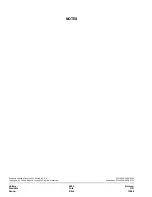
035-18549-000-B-0402
Unitary Products Group
13
3.
Unbraze the coil's liquid line disc while maintaining
a flow of dry nitrogen across the connection and
through the hole in the liquid line disc.
4.
After the disc has been removed, burnish the exter-
nal surfaces and clean the internal surfaces as out-
lined above.
5.
Move the dry nitrogen supply back to the access
port on the liquid line service valve.
6.
Braze the liquid line to the liquid connection on the
indoor unit while maintaining a minimum flow of dry
nitrogen through the liquid line, the indoor coil and
the hole in the vapor disc.
7.
Unbraze the disc on the vapor connection of the
indoor unit while maintaining the flow of dry nitro-
gen.
8.
After the disc has been removed, burnish the exter-
nal surfaces and clean the internal surfaces as out-
lined above.
The vapor piping can now be brazed to the vapor con-
nection on the indoor unit while maintaining a minimum
flow of dry nitrogen.
Before brazing the vapor line to the outdoor unit, make
sure the refrigerant in the line has been recovered,
then remove the copper disc from its vapor connection
per the following procedure:
1.
Make sure that the vapor line service valve on the
outdoor unit is front-seated and closed with its
valve stem in the maximum clockwise position.
2.
Drill a small hole through the disc before unbrazing
it to permit a flow of dry nitrogen through the con-
nection while its being unbrazed.
3.
Move the dry nitrogen supply to the access port on
the vapor line service valve of the outdoor unit.
4.
Unbraze the disc on the vapor line connection of
the outdoor unit while maintaining a minimum flow
of dry nitrogen through the access port of the vapor
line service valve and the hole in the vapor disc.
5.
After the disc has been removed, burnish the exter-
nal surfaces and clean the internal surfaces of the
vapor connection and the vapor piping.
The vapor line can now be brazed to the vapor connec-
tion on the outdoor unit while maintaining the flow of
dry nitrogen.
After the liquid and vapor lines have been installed, the
system should be evacuated and charged.
EVACUATING AND CHARGING
With the liquid and suction line service valves closed,
connect a vacuum pump through a charging manifold
to the access ports on both the liquid and suction line
service valves.
NOTE: The vacuum pump connection should be short
and no smaller than 3/8" O.D.
The refrigerant lines and the evaporator coil can now
be evacuated to 500 Microns without disturbing the
charge in the condenser coil or the compressor.
After proper evacuation and dehydration, charge refrig-
erant through the access port on the liquid line service
valve allowing the vacuum to draw in as much refriger-
ant as possible.
To continue charging refrigerant, open the liquid and
the suction line service valves fully. Turn the stem of
the liquid service valve clockwise 1/4 turn to open its
access port for reading pressure.
Start the compressor (after 8 hours of crankcase heat),
turn the stem of the suction line service valve clockwise
1/4 turn to open its service port and continue to charge
refrigerant gas through this suction access port until
you meet the conditions shown on the charging curve,
Fig. 8.
Open the liquid and vapor line service valves fully to
close their access ports after the system has been
charged.
Do not charge liquid refrigerant through the
compressor suction connection.
Do not attempt to start the compressor without
at least 8 hours of crankcase heat or compres-
sor damage will occur.
























